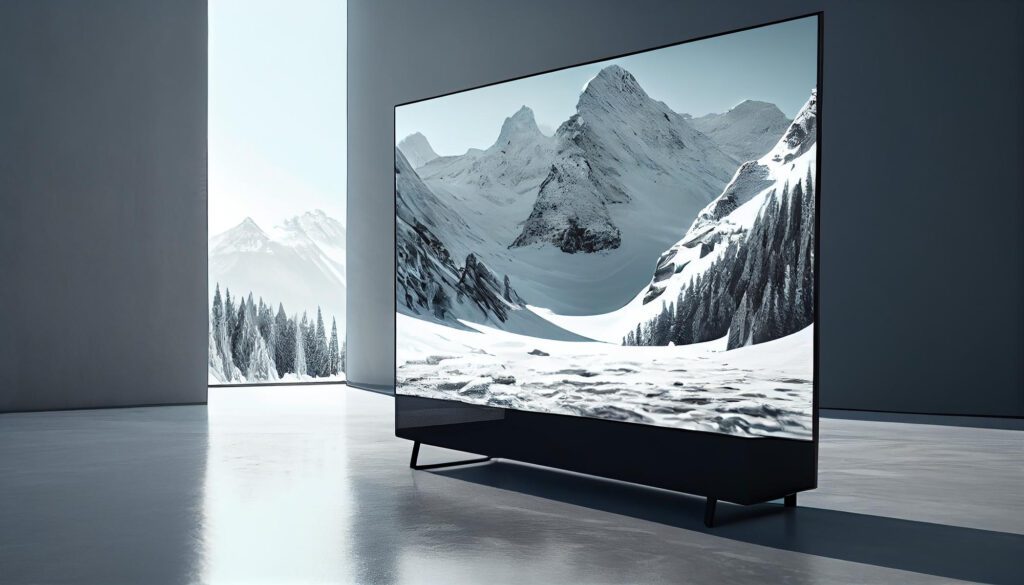Two leading competitors in the rapidly changing field of display technology are Full Array LED (FALD) and OLED. Our visual experiences have been transformed by these technologies, yet each has a special combination of benefits and drawbacks. This post will examine Full Array LED vs OLED technologies, provide a detailed comparison, and assist you in selecting the best option for your display requirements.
Table of Contents
Understanding Full Array LED Technology
Full Array LED technology is all about delivering vibrant and lifelike visuals. It consists of an array of LEDs directly behind the screen, rather than along the edges. This setup allows for precise control over individual LED zones, resulting in exceptional picture quality and vivid colors.
Benefits of Full Array LED
- Enhanced Picture Quality: The direct LED placement ensures uniform brightness across the screen, eliminating issues like “halo” effects.
- Improved Contrast: FALD technology offers better control over light and dark areas, leading to higher contrast ratios.
Exploring OLED Technology

OLED, or Organic Light-Emitting Diode, technology is renowned for its self-emissive nature. Each pixel in an OLED display emits its light, allowing for true blacks and infinite contrast ratios. Smartphones and high-end televisions now have this technology.
Advantages of OLED
- Infinite Contrast: OLED’s ability to turn individual pixels on or off results in absolute black levels and stunning contrast.
- Ultra-Thin Displays: OLED screens are incredibly thin and flexible, making them suitable for various applications.
Read More AMD Ryzen vs Intel Core i7: Battle of the Processors
Full Array LED vs OLED: A Comparative Analysis
Let’s dive into the key factors that set these technologies apart:
Picture Quality:
Full Array LED offers excellent picture quality, but OLED takes it a step further with its self-emissive pixels. This means OLED displays can achieve perfect black levels, resulting in breathtaking visuals.
Contrast Ratio:
OLED reigns supreme here, providing an infinite contrast ratio. FALD, while impressive, can’t quite match the absolute blacks of OLED.
Black Levels:
OLED delivers pure black levels, ensuring that dark scenes are truly immersive. Full Array LED, though, may show some backlighting in dark areas.
Viewing Angles:
OLED excels in this category, as it maintains its picture quality even when viewed from extreme angles. Full Array LED displays may experience some loss in quality at extreme angles.
Power Efficiency:
Full Array LED is generally more power-efficient than OLED. If you’re conscious of energy consumption, FALD might be the way to go.
When deciding among Full Array LED vs OLED, it’s critical to take your demands, tastes, and financial situation into account. Which technology is right for you ultimately depends on your priorities. Each of these technologies has distinct benefits and features.
Have a look at ASUS ROG Zephyrus G14: The Ultimate Gaming Beast Unveiled

Consider Your Usage
Your usage patterns play a significant role in determining the ideal technology for you. For example:
- Movie Enthusiasts: If you love cinematic experiences with deep blacks and stunning contrast, OLED is the clear winner. The infinite contrast ratio ensures that every scene is immersive, and the self-emissive nature of OLED technology delivers impeccable visuals.
- Gamers: Gamers often seek fast response times and vibrant visuals. Both Full Array LED and OLED can provide excellent gaming experiences, but OLED’s contrast advantage makes it a compelling choice for gamers who want the best visual experience.
- Casual Viewers: If you’re looking for a TV for everyday use, casual viewing, and you’re on a budget, Full Array LED can be a suitable choice. It offers good picture quality and is often more affordable than OLED.
Budget Considerations ( Full Array LED vs OLED)
Your budget is another crucial factor when deciding between Full Array LED vs OLED displays. Here’s a detailed list of what to expect:
- OLED: OLED displays are generally more expensive than their Full Array LED counterparts. If you’re willing to invest in a top-tier display and value unparalleled picture quality, OLED might be the way to go.
- Full Array LED: Full Array LED displays offer a more budget-friendly option for those who want a good visual experience without breaking the bank. You can still enjoy vibrant colors and decent contrast without the premium OLED price tag.
The Future of Display Technology
The display technology industry is a dynamic, ever-changing field. Both of Full Array LED vs OLED technologies are expected to advance and develop in the future.
Quite possibly’s more individuals will approach OLED advances. With more effective creation techniques, OLED could turn out to be more reasonable and open to a more extensive scope of shoppers.
On the other hand, Full Array LED displays might keep improving their black depths and contrast ratios, closing the difference between the two technologies.
Ultimately, the future of display technology promises exciting developments for display enthusiasts and consumers alike.
Conclusion
In the battle of Full Array LED vs OLED, there’s no one-size-fits-all answer. Your choice depends on what you value most in a display – be it the stunning contrast and self-emissive magic of OLED or the budget-friendly performance of Full Array LED.
So, consider your usage, budget, and priorities carefully. With the information provided in this article, you’re now well-equipped to make an informed decision that aligns with your preferences and delivers an exceptional visual experience tailored to you.
Read more Mastering Precision: How to Change DPI of Mouse In Enhanced 6 Proven Steps
FAQs

1. Is OLED better than Full Array LED for gaming?
A) OLED’s contrast and black levels make it an excellent choice for gaming, but Full Array LED can still provide a great gaming experience.
2. Are OLED displays more prone to burn-in?
A) Yes, OLED displays can experience burn-in if static images are displayed for extended periods. Full Array LED displays are less susceptible to this issue.
3. Which technology is better for outdoor displays?
A) Full Array LED is a better choice for outdoor displays due to its higher brightness levels.
4. Do OLED displays consume more power than Full Array LED displays?
A) Yes, OLED displays generally consume more power than Full Array LED displays.
5. Can OLED technology be used in larger screen sizes?
A) While OLED technology is available in larger sizes, it can be quite expensive for larger displays. Full Array LED is a more cost-effective option for big screens.

